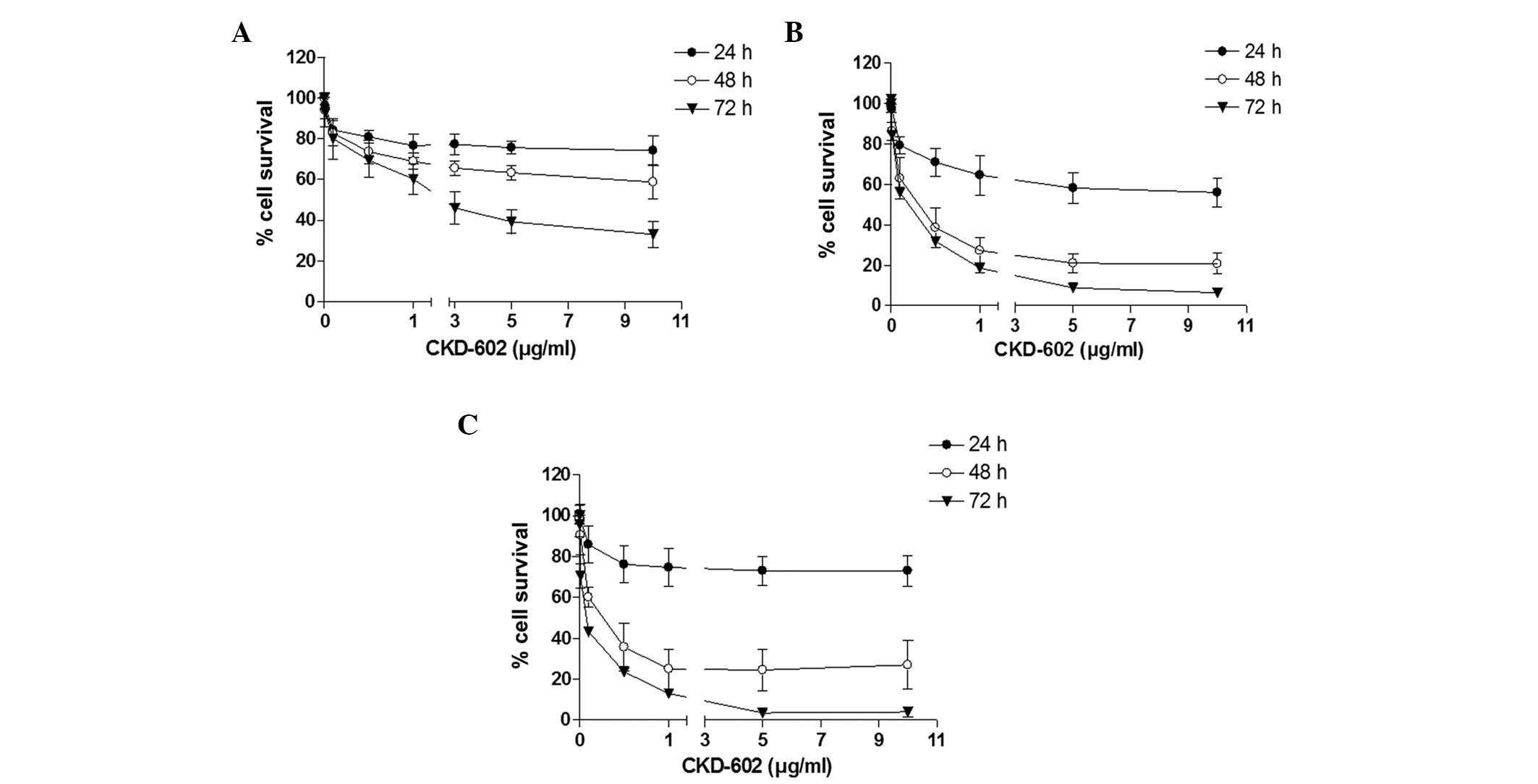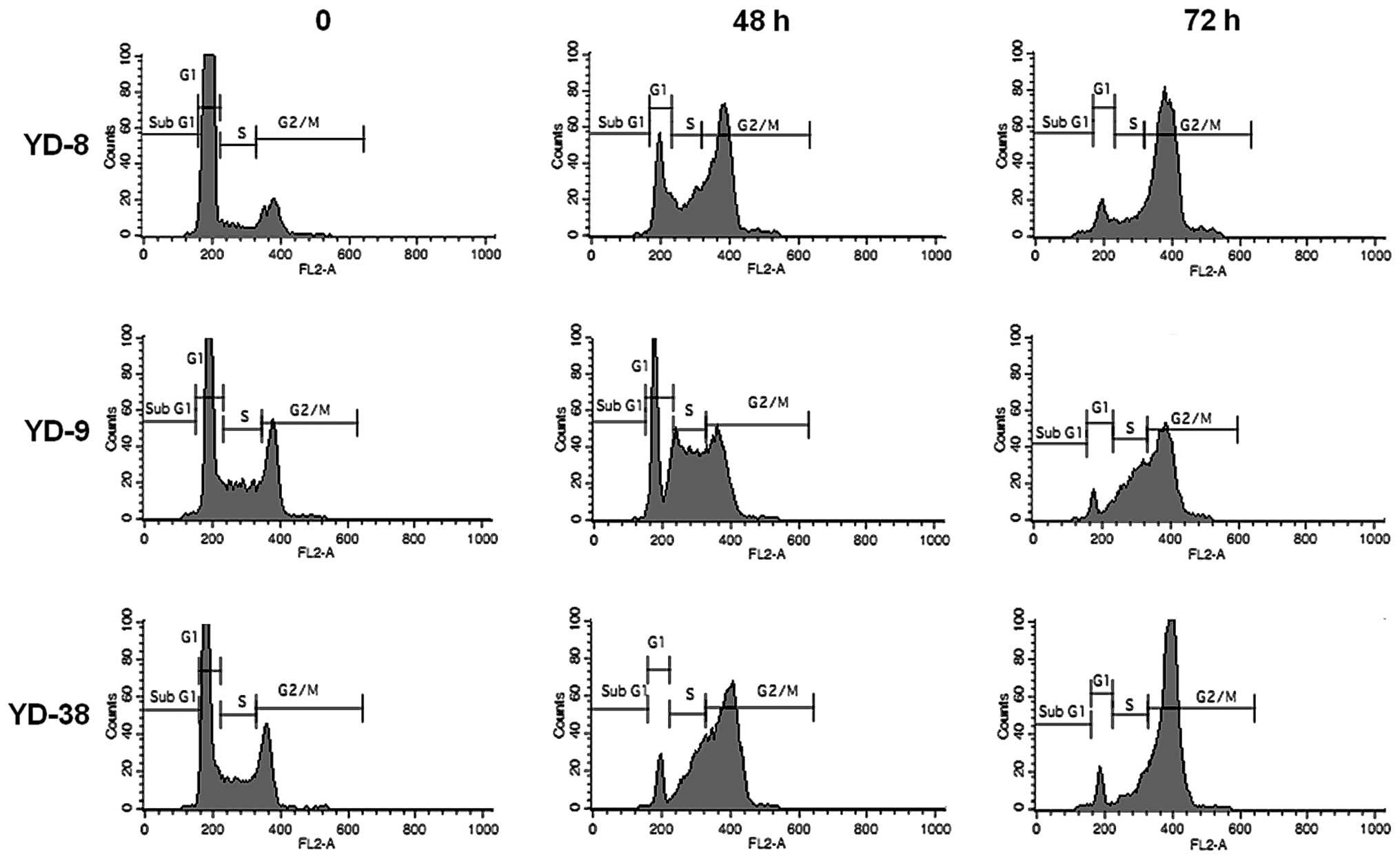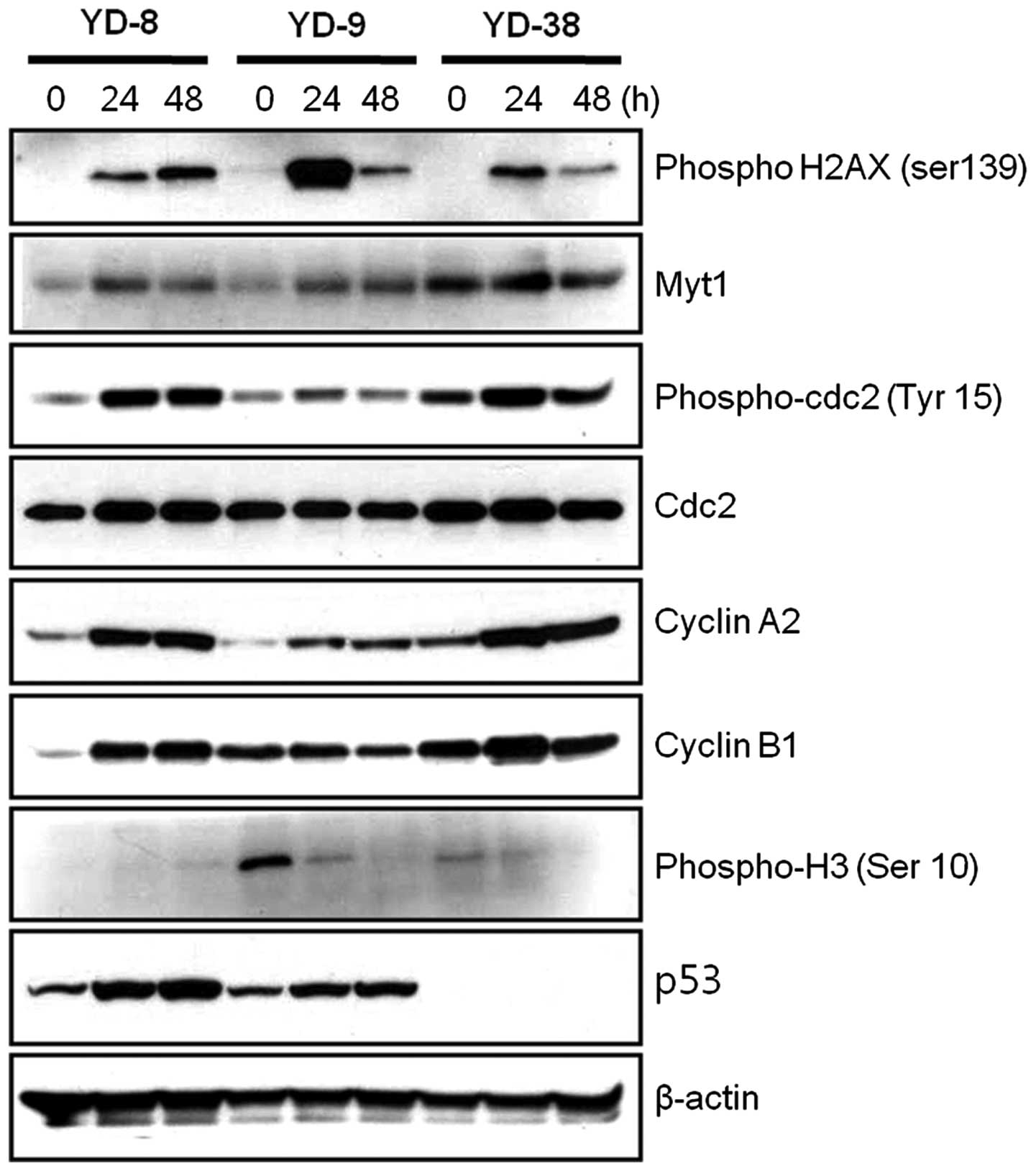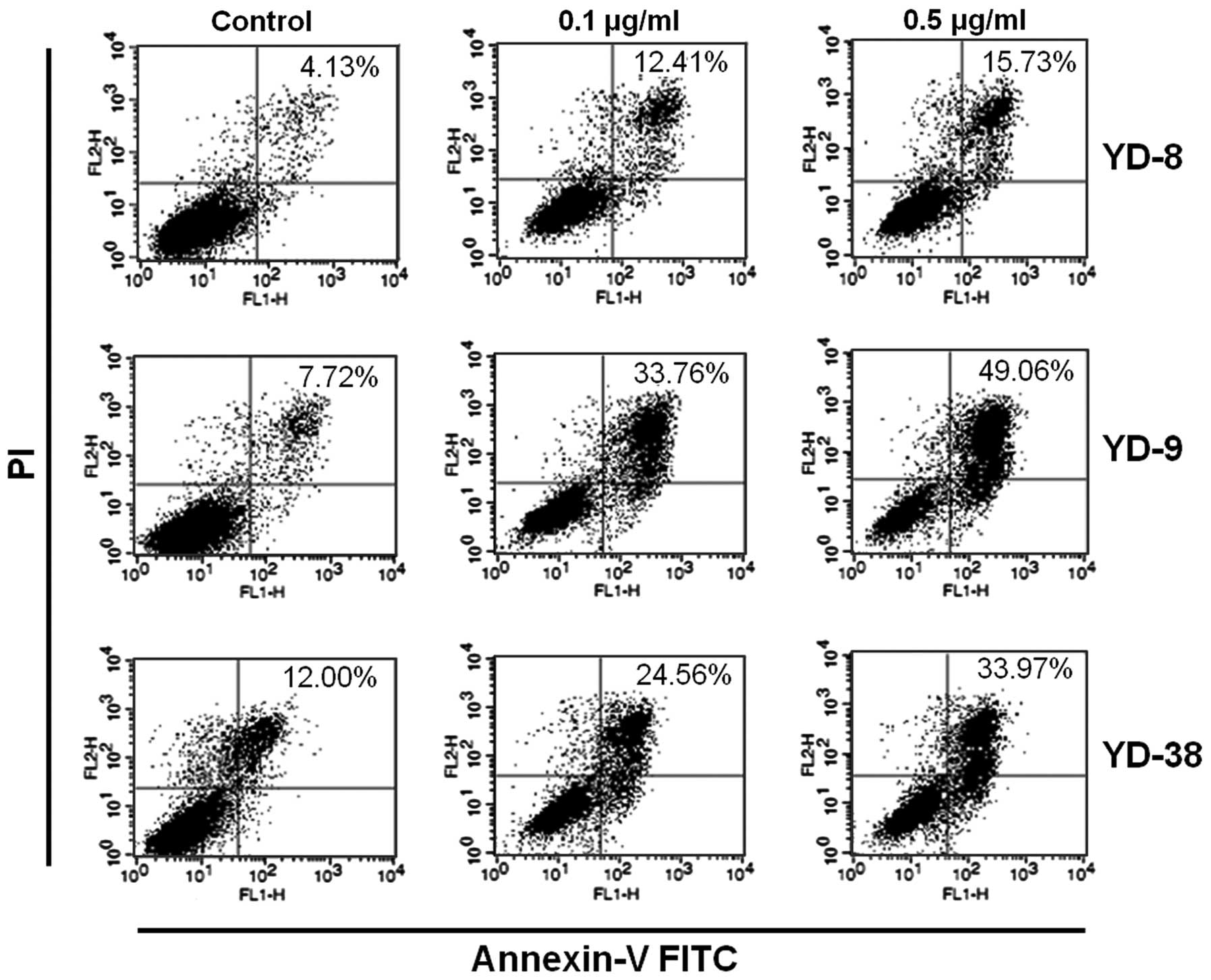|
1
|
Kim KM, Kim YM, Shim YS, et al: Study
Group of Korean Society of Head and Neck Surgerons: Epidemiologic
survey of head and neck cancers in Korea. J Korean Med Sci.
18:80–87. 2003. View Article : Google Scholar : PubMed/NCBI
|
|
2
|
Parkin DM: Global cancer statistics in the
year 2000. Lancet Oncol. 2:533–543. 2001. View Article : Google Scholar
|
|
3
|
Easty DM, Easty GC, Carter RL, Monaghan P
and Butler LJ: Ten human carcinoma cell lines derived from squamous
carcinomas of the head and neck. Br J Cancer. 43:772–785. 1981.
View Article : Google Scholar : PubMed/NCBI
|
|
4
|
Nicolson GL: Tumor progression, oncogenes
and the evolution of metastatic phenotypic diversity. Clin Exp
Metastasis. 2:85–105. 1984. View Article : Google Scholar : PubMed/NCBI
|
|
5
|
Lee EJ, Kim J, Lee SA, et al:
Characterization of newly established oral cancer cell lines
derived from six squamous cell carcinoma and two mucoepidermoid
carcinoma cells. Exp Mol Med. 37:379–390. 2005. View Article : Google Scholar : PubMed/NCBI
|
|
6
|
Scheffner M, Werness BA, Huibregtse JM, et
al: The E6 oncoprotein encoded by human papillomavirus types 16 and
18 promotes the degradation of p53. Cell. 63:1129–1136. 1990.
View Article : Google Scholar : PubMed/NCBI
|
|
7
|
Hainaut P, Hernandez T, Robinson A, et al:
IARC Database of p53 gene mutations in human tumors and cell lines:
updated compilation, revised formats and new visualisation tools.
Nucleic Acids Res. 26:205–213. 1998. View Article : Google Scholar : PubMed/NCBI
|
|
8
|
Tagscherer KE, Fassl A, Sinkovic T, Combs
SE and Roth W: p53-dependent regulation of Mcl-1 contributes to
synergistic cell death by ionizing radiation and the Bcl-2/Bcl-XL
inhibitor ABT-737. Apoptosis. 17:187–199. 2012. View Article : Google Scholar
|
|
9
|
Champoux JJ: DNA topoisomerases:
structure, function, and mechanism. Annu Rev Biochem. 70:369–413.
2001. View Article : Google Scholar : PubMed/NCBI
|
|
10
|
Pommier Y, Leo E, Zhang H and Marchand C:
DNA topoisomerases and their poisoning by anticancer and
antibacterial drugs. Chem Biol. 17:421–433. 2010. View Article : Google Scholar : PubMed/NCBI
|
|
11
|
Gupta M, Fujimori A and Pommier Y:
Eukaryotic DNA topoisomerases I. Biochim Biophys Acta. 1262:1–14.
1995. View Article : Google Scholar : PubMed/NCBI
|
|
12
|
Wang JC: Cellular roles of DNA
topoisomerases: a molecular perspective. Nat Rev Mol Cell Biol.
3:430–440. 2002. View
Article : Google Scholar : PubMed/NCBI
|
|
13
|
Lee JH, Lee JM, Kim JK, et al: Antitumor
activity of 7-[2-(N-isopropylamino)ethyl]-(20S)-camptothecin,
CKD602, as a potent DNA topoisomerase I inhibitor. Arch Pharm Res.
21:581–590. 1998. View Article : Google Scholar
|
|
14
|
Ok YJ, Myoung H, Kim YK, et al: Apoptotic
effect of CKD-602 (Camtobell) on oral squamous cell carcinoma cell
lines. Oral Oncol. 45:266–272. 2009. View Article : Google Scholar
|
|
15
|
Booher RN, Holman PS and Fattaey A: Human
Myt1 is a cell cycle-regulated kinase that inhibits Cdc2 but not
Cdk2 activity. J Biol Chem. 272:22300–22306. 1997. View Article : Google Scholar : PubMed/NCBI
|
|
16
|
Liu F, Stanton JJ, Wu Z and Piwnica-Worms
H: The human Myt1 kinase preferentially phosphorylates Cdc2 on
threonine 14 and localizes to the endoplasmic reticulum and Golgi
complex. Mol Cell Biol. 17:571–583. 1997.PubMed/NCBI
|
|
17
|
Parker LL and Piwnica-Worms H:
Inactivation of the p34cdc2-cyclin B complex by the human WEE1
tyrosine kinase. Science. 257:1955–1957. 1992. View Article : Google Scholar : PubMed/NCBI
|
|
18
|
Van Hooser A, Goodrich DW, Allis CD,
Brinkley BR and Mancini MA: Histone H3 phosphorylation is required
for the initiation, but not maintenance, of mammalian chromosome
condensation. J Cell Sci. 111:3497–3506. 1998.PubMed/NCBI
|
|
19
|
Holden JA: DNA topoisomerases as
anticancer drug targets: from the laboratory to the clinic. Curr
Med Chem Anticancer Agents. 1:1–25. 2001. View Article : Google Scholar
|
|
20
|
Kim YY, Park CK, Kim SK, et al: CKD-602, a
camptothecin derivative, inhibits proliferation and induces
apoptosis in glioma cell lines. Oncol Rep. 21:1413–1419.
2009.PubMed/NCBI
|
|
21
|
Lee JH, Lee JM, Lim KH, et al: Preclinical
and phase I clinical studies with Ckd-602, a novel camptothecin
derivative. Ann N Y Acad Sci. 922:324–325. 2000. View Article : Google Scholar
|
|
22
|
Wang Y, Zhu S, Cloughesy TF, Liau LM and
Mischel PS: p53 disruption profoundly alters the response of human
glioblastoma cells to DNA topoisomerase I inhibition. Oncogene.
23:1283–1290. 2004. View Article : Google Scholar : PubMed/NCBI
|
|
23
|
Gupta M, Fan S, Zhan Q, et al:
Inactivation of p53 increases the cytotoxicity of camptothecin in
human colon HCT116 and breast MCF-7 cancer cells. Clin Cancer Res.
3:1653–1660. 1997.
|
|
24
|
Bunz F, Dutriaux A, Lengauer C, et al:
Requirement for p53 and p21 to sustain G2 arrest after DNA damage.
Science. 282:1497–1501. 1998. View Article : Google Scholar : PubMed/NCBI
|
|
25
|
Djuzenova CS, Güttler T, Berger S, Katzer
A and Flentje M: Differential response of human glioblastoma cell
lines to combined camptothecin and ionizing radiation treatment.
Cancer Biol Ther. 7:364–373. 2008. View Article : Google Scholar
|
|
26
|
Morandi E, Severini C, Quercioli D, et al:
Gene expression time-series analysis of camptothecin effects in
U87-MG and DBTRG-05 glioblastoma cell lines. Mol Cancer. 7:662008.
View Article : Google Scholar : PubMed/NCBI
|
|
27
|
Wong RH, Du CL, Wang JD, et al: XRCC1 and
CYP2E1 polymorphisms as susceptibility factors of plasma mutant p53
protein and anti-p53 antibody expression in vinyl chloride
monomer-exposed polyvinyl chloride workers. Cancer Epidemiol
Biomarkers Prev. 11:475–482. 2002.PubMed/NCBI
|
|
28
|
Yook JI and Kim J: Expression of
p21WAF1/CIP1 is unrelated to p53 tumour suppressor gene status in
oral squamous cell carcinomas. Oral Oncol. 34:198–203. 1998.
View Article : Google Scholar : PubMed/NCBI
|













